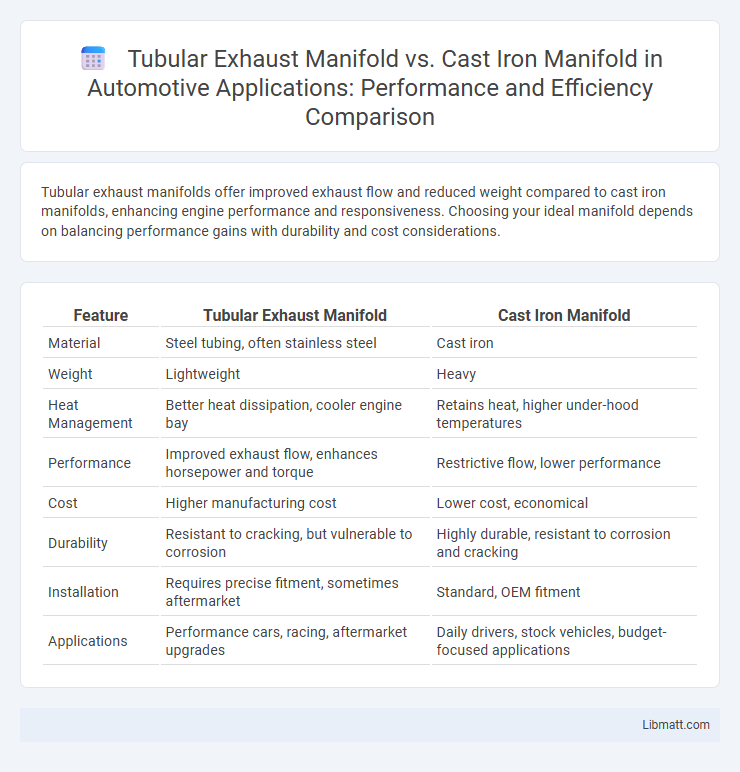Tubular exhaust manifolds offer improved exhaust flow and reduced weight compared to cast iron manifolds, enhancing engine performance and responsiveness. Choosing your ideal manifold depends on balancing performance gains with durability and cost considerations.
Table of Comparison
| Feature | Tubular Exhaust Manifold | Cast Iron Manifold |
|---|---|---|
| Material | Steel tubing, often stainless steel | Cast iron |
| Weight | Lightweight | Heavy |
| Heat Management | Better heat dissipation, cooler engine bay | Retains heat, higher under-hood temperatures |
| Performance | Improved exhaust flow, enhances horsepower and torque | Restrictive flow, lower performance |
| Cost | Higher manufacturing cost | Lower cost, economical |
| Durability | Resistant to cracking, but vulnerable to corrosion | Highly durable, resistant to corrosion and cracking |
| Installation | Requires precise fitment, sometimes aftermarket | Standard, OEM fitment |
| Applications | Performance cars, racing, aftermarket upgrades | Daily drivers, stock vehicles, budget-focused applications |
Introduction to Exhaust Manifolds
Exhaust manifolds are critical components that gather engine exhaust gases and direct them into the exhaust system. Tubular exhaust manifolds, often made from stainless steel, feature individual pipes for each cylinder, improving exhaust flow and engine efficiency. Cast iron manifolds provide durability and heat resistance but may restrict exhaust flow due to their solid, bulky design.
What is a Tubular Exhaust Manifold?
A tubular exhaust manifold is a high-performance automotive component composed of smooth, individual steel or stainless steel tubes that merge into a single outlet, designed to improve exhaust flow and reduce back pressure. Compared to cast iron manifolds, tubular designs enhance engine efficiency and power by facilitating quicker expulsion of exhaust gases and minimizing heat retention. These manifolds are often preferred in racing and high-performance vehicles due to their lightweight construction and superior thermal management capabilities.
What is a Cast Iron Manifold?
A cast iron manifold is an exhaust component made from durable, heavy-duty cast iron that offers excellent heat retention and resistance to cracking compared to tubular designs. Unlike tubular exhaust manifolds that use individual pipes welded together, cast iron manifolds are a single solid piece, providing a more compact and quieter operation. If you're considering durability and cost-effectiveness for your vehicle, a cast iron manifold is often a reliable choice.
Material and Construction Differences
Tubular exhaust manifolds are constructed from welded steel or stainless steel tubes, designed to optimize exhaust flow with smoother bends and consistent diameter, enhancing engine efficiency and performance. Cast iron manifolds are made from a single, solid piece of cast iron, providing durability and heat resistance but often resulting in less efficient exhaust gas flow due to their bulkier, less aerodynamic design. Your choice between tubular and cast iron manifolds impacts engine responsiveness, heat management, and overall vehicle performance.
Performance Benefits: Tubular vs Cast Iron
Tubular exhaust manifolds offer superior performance benefits over cast iron manifolds by improving exhaust gas flow through smoother, mandrel-bent tubing, which reduces backpressure and enhances engine efficiency. This design leads to increased horsepower and torque due to better scavenging and optimized exhaust pulse timing, especially in high-performance applications. Your engine gains quicker throttle response and improved fuel efficiency with a tubular exhaust system, while cast iron manifolds typically prioritize durability and cost-effectiveness over performance gains.
Heat Management and Thermal Efficiency
Tubular exhaust manifolds excel in heat management by promoting better exhaust gas flow and reducing heat retention due to their lightweight, thin-walled construction, which improves thermal efficiency and engine performance. Cast iron manifolds, while durable and resistant to cracking, tend to retain more heat, increasing under-hood temperatures and potentially reducing overall thermal efficiency. Choosing tubular exhaust manifolds can better optimize Your engine's heat dissipation and enhance fuel efficiency by maintaining lower manifold temperatures.
Durability and Longevity Comparison
Tubular exhaust manifolds, constructed from high-quality stainless steel, offer superior resistance to rust and thermal cracking, significantly enhancing durability compared to cast iron manifolds. Cast iron manifolds, while known for their strength and heat retention, are more prone to cracking under rapid temperature changes and prolonged stress. Your engine's longevity benefits from tubular designs as they maintain structural integrity longer, reducing the need for frequent replacements.
Installation and Compatibility
Tubular exhaust manifolds offer easier installation due to their lightweight design and standardized flange patterns compatible with most performance engines. Cast iron manifolds require careful alignment and may need specific mounting hardware because of their heavier construction and unique OEM fitment. Compatibility with engine models varies, with tubular manifolds favoring aftermarket upgrades and cast iron manifolds preferred for direct replacement in stock configurations.
Cost and Maintenance Considerations
Tubular exhaust manifolds typically cost more upfront due to their performance-oriented design and use of lightweight materials, while cast iron manifolds are generally less expensive and more durable. Maintenance for tubular manifolds may involve more frequent inspections and potential repairs because of their susceptibility to cracking from heat stress, whereas cast iron manifolds are heavier but require less frequent upkeep due to their robust construction. Choosing between the two depends on balancing your budget with long-term maintenance preferences and performance goals.
Which Manifold is Right for Your Vehicle?
Choosing the right exhaust manifold for your vehicle depends on performance goals and durability preferences. Tubular exhaust manifolds, often made from stainless steel, offer improved exhaust flow and increased horsepower, making them ideal for high-performance applications. Cast iron manifolds provide superior heat retention and long-lasting durability, suitable for daily driving and heavy-duty use where reliability is paramount.
Tubular Exhaust Manifold vs Cast Iron Manifold Infographic

 libmatt.com
libmatt.com